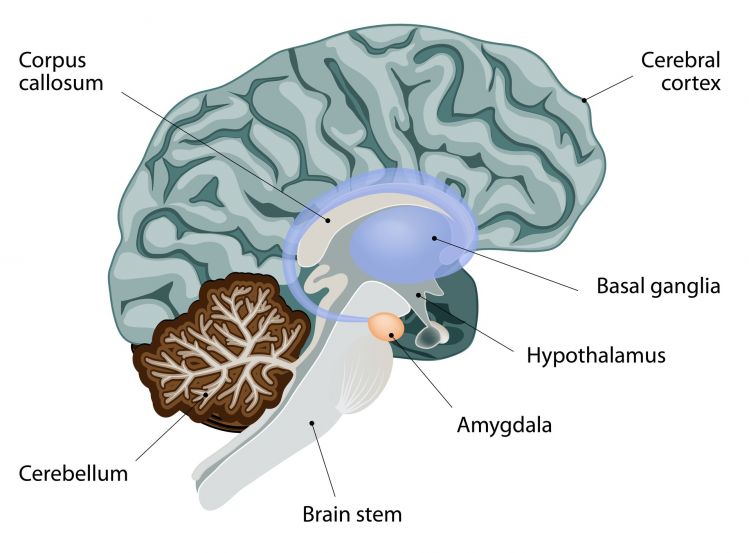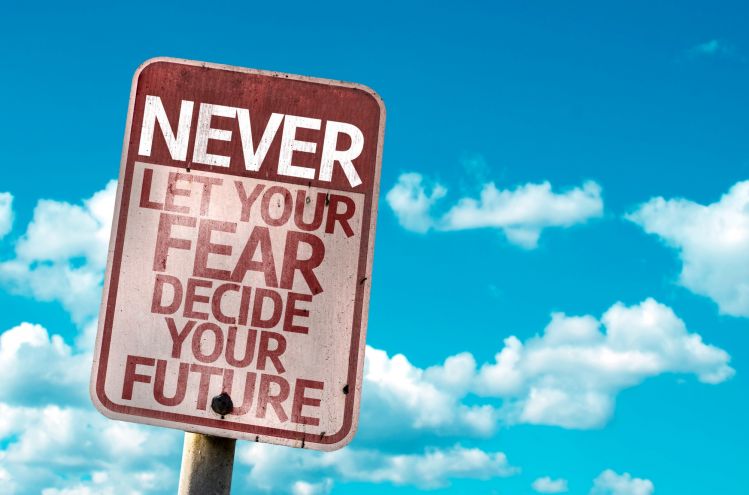Managing your fears and anxieties
Lesson 3
Introduction
There are some things we all share with “lower” life forms. Most have a heart, a brain, lungs. But in the most primitive part of the mind, there lurks a place called the amygdala that developed to maintain our survival and evolutionary genetic linkage.
In humans, it’s about the size and shape of an almond, and its function is to keep us alive long enough to reproduce to maintain the species existence.
The amygdala’s additional involvement in the formation of emotional memories may explain why we recall specific events after smelling a particular scent.
It’s in all mammals, varying slightly in size, and it serves a fundamental purpose. Simply put, it tells us what to do when we’re in danger.
The amygdala is responsible for fear conditioning.
Experts believe the brain stores fear memories in the connections between the nuclei in the amygdala has a role in the fear response.

Amygdala function
Located deep in the brain's left and right temporal lobes, our two amygdalae are important for numerous aspects of thought, emotion and behaviour, and are implicated in a variety of neurological and psychiatric conditions.
When you hear you the phrase “fight or flight” that’s referring to the work of the amygdala.
There are some tremendous benefits to this system, for example, when something big and loud is coming at you, you’re probably already running before you even know what it is.
The amygdala keeps you alive by pumping adrenaline into your system.
What we do with it, becomes that reaction which keeps us alive. After an event occurs, the brain stores the memory temporarily.
Over time, it converts the memory information into long-term memory.
During this switch, the amygdala can affect or modulate the memory. If the memory was incredibly emotional, then the amygdala strengthens the memory pathway and allows a person to recall it better. This may explain why post-traumatic stress disorder often involves vivid recollections of past trauma.
Fight Or flight response
Are you going to stay and face the enemy, or will you run away?
We have previously mentioned the fight or flight system, and the problem is, what was useful centuries ago has limited use in today’s world. After all, this reaction is built into the deepest, most intuitive part of our brain.
But what do we need it for anymore other than to get you to jump up on the occasional curb when a taxi tries to take you out in the crosswalk?
When you hear yourself saying that something is too risky, that something is too dangerous, that you shouldn’t do it, that’s the amygdala talking. So while everything might not be life or death anymore, having a part of your brain on a sense of duty to keep you a little cautious, isn’t necessarily a bad thing.
Except, it is. The worst part of the amygdala is that everything goes through there first before going on to other parts of the brain.
And while that can be handy when driving, making you more alert to other drivers, and it can be handy in dark alleys and war zones, when you’re looking to make a change to reach out past your comfort zone and try to achieve something new, it kind of gets in the way.
That’s when you hear the voice.
You know the one. It says things like:
“That’s too risky.”
“It’s too dangerous.”
“What if I fail?”
“What if I go broke?”
“What about my retirement fund?”
“It’s a pipe dream.”
“Don’t take chances!”
What you need to realise is that people who succeed are people who take risks. Believe it or not, people who are rich often lose vast fortunes on the chances they take, but they keep going, and that’s where the next risk pays off.
You cannot be successful if you continually listen to your amygdala, or “lizard brain” because you’ll always end up giving in to your fear.
However, our instinct is to run, to flee from risk. Our very being is designed to fight change and to run from challenges.
Believe it or not, you can change this. Keep in mind; these reactions are so deeply embedded; they aren’t going to change overnight. And they certainly won’t change easily. But it can be done.
Anxiety disorders
Anxiety is a perfectly normal and healthy reaction to threatening or dangerous situations; it continues to be significant for our survival as it is our natural protection - a built-in alarm if you like. Anxiety can affect us mentally, physically, or both.
Sometimes we may feel anxious, but we don’t know why - this can be a constant feeling that feels out of proportion to the situation, or waves of anxiety that come and go. When this starts to affect your daily life, it can become overwhelming, and you may feel out of control.
Everyone will experience anxiety differently, and we all have our triggers; we may not always know what causes our fear, which can feel upsetting and stressful and can cause further anxious feelings. We don’t always have control over things that affect our mental health; factors such as our environment, grief, past and present circumstances, previous trauma or our childhood experiences can all influence our mental and emotional state.
It is important to remember that anxiety feels different for everyone; nevertheless, there are some common symptoms, listed below.
You might also experience other symptoms or difficulties that aren’t listed here:
- Feeling nervous, on edge, or panicky all the time
- Feeling overwhelmed or full of dread
- Feeling out of control
- Having trouble sleeping
- Low appetite
- Finding it difficult to concentrate
- Feeling tired and grumpy
- Heart beating fast or thinking you have a heart attack
- Having a dry mouth
- Trembling
- Feeling faint
- Stomach cramps and/or diarrhoea/ needing to pee more than usual
- Sweating more than usual
- Wobbly legs
- Getting very hot.
These symptoms are prevalent during periods of anxiety and stress. They can be unpleasant but acknowledging and recognising that these symptoms are a result of your anxiety is a precious step in helping you begin to be able to manage them.
Feelings of anxiety begin with a trigger that set off a catalyst of events -- a sight, smell, or sense that then results in anxiety. The amygdala handles the catalyst by either preparing to fight or equally to prepare you to run.
As part of this process, produce more serotonin receptors in their amygdalae, whereas females lose them. This may result in males being less responsive to stressful stimuli and feelings of anxiety.
The fight or flight response is responsible for the various physical effects that anxiety can have.
Learning to recognise your particular triggers is the beginning of a journey to gain control of your emotional and physical reactions and feel better equipped to deal with these situations in the future, in a less stressful way for the mind and body.
The first step is to try and understand your anxiety and where it came from.
Treatment process
Start to make a list, diary or spreadsheet, recording the following:
- What triggered you
- Why do you think you were triggered
- When it happened
- Where you were
- How you felt
- How you reacted/what happened
- How long it lasted.
Once you have all this information, you will then have a better understanding of what your triggers are and where they came from.
Knowing - and understanding - the root cause of your anxiety will help you create your own unique plan to support you moving forward, a process known as ‘reframing’.
To do this, you need to expose yourself to your common triggers so you can look at your thoughts and feelings from a different perspective.
During this exposure and reframing process, it helps to have what I like to call a ‘toolbox’ of thoughts, experiences or actual activities you can do to calm yourself, if or when you start to feel out of control.
A lot of individuals with anxiety want to avoid situations that cause them to feel anxious, but this is actually making the problem worse.
To be able to manage your anxiety, you need to face your triggers head-on and retrain your mind and body to respond differently.
If you feel like you would benefit from extra support too, a counsellor will help you to explore your individual experience of anxiety in a safe, secure environment; together you will build an empathetic, non-judgemental and autonomous therapeutic relationship.
Serotonin / 5-hydroxytryptamine (5HT)

Serotonin or 5 HT, depending upon which side of the pond you live, (USA /British) is a chemical term used to identify a natural neurotransmitter, a chemical that helps relay signals from one area of the nervous system to another, and it appears to play a significant role in mood regulation.
This hormone/chemical was previously mentioned with regards to feelings of anxiety, above.
Boosting this chemical can cause a more positive mood and stabilise feelings of happiness with other benefits in many individuals. If you ever want to hear a psychologist or biochemist groan, refer to it as a happy pill or hormone. However, it remains unclear whether low serotonin levels cause depression, while higher levels can lead to agitation. It is still unclear whether depression causes the brain to reduce serotonin production in the first place.
Research into serotonin’s effects on mood and behaviour has led to the creation of the SSRI class of drugs -- selective serotonin reuptake inhibitors. These drugs can reduce symptoms of depression and anxiety in many people, and as of 2019, they are the most commonly prescribed antidepressants.
SSRIs are generally safe, although their effectiveness varies and they do come with the potential for significant side effects.
Correcting low serotonin levels often starts with lifestyle improvements, and exercise and a healthy diet can influence serotonin levels naturally. Regular meditation may also help reduce stress and thus boost serotonin.
I learned that courage was not the absence of fear, but the triumph over it. The brave man is not he who does not feel afraid, but he who conquers that fear. {Nelson Mandela}
That’s Neuro-linguistic programming (NLP). Every time you conquer fear, you put a little reprogramming into the amygdala. Not that you want it to go away completely. We still need it on duty for those critical moments for when we indeed are in danger. But we need to listen to it only when we truly need it—when there is real danger ahead.
Only then will you find success.
How many times have you been looking forward to something that scares you?
How often do you think that a frightening situation is going to turn out great?
Chances are, unless you’re a lover of haunted houses, never.
Fear does not have a bright side.
Fear does not have a happy ending.
Fear will only see the downside, the disaster waiting to happen, the pit that opens under your feet.
Fear cannot see the success at the end of the journey or the benefits that taking a risk can bring.
- Ready to make a speech?
What if you mumble?
- Ready to go on a date?
What if they don’t like you?
- Ready to get a promotion?
What if the new job is too much to handle?
Fear does this. Instead of knowing that you’re going to have the audience’s rapt attention, or that you might meet that one person you’ve dreamed of, or celebrating that corner office they’ll award you, fear will only let you see the pitfall and traps, and they grow larger and larger by the minute.

Why does fear hold us back?
What is it that makes us so afraid?
Fear is Immediate
Remember, everything goes through the amygdala.
Were you being chased by a rabid wolf?
Not the time to stop and think too hard about it.
Getting one offer on selling your car for half the price you asked? That is an excellent time to stop and think things over. But fear won’t let you stop and think.
The amygdala is designed to make you react quickly.
If you’re afraid that there will be no more offers for your car, or if you’re afraid that there is not going to be another option in work, relationships, or whatever it may be, there’s no option to think things through. Fear, scream now!
Often to long-term regret.
Better the Devil You Know

Often animals kept in cages too long, even abused ones, will fight to remain in their cages when finally offered freedom. They understand where they are now and know what to expect.
Whatever lies beyond the small enclosure is too big, too grand and frightening even to consider.
It’s much the same reason as to why people will remain in abusive relationships.
They’ll work relentlessly in dead-end jobs with bad employers but will stay where they are, with the ill-treatment, because it’s familiar to them.
Fear of the unknown is often much scarier than the certainty of where we already are.
Fear keeps us from leaving, from getting help, from striking out on our own when we can no longer tolerate the life we have. Fear keeps us “safe,” even when we are not at all safe.
Helen Keller put it this way: “Avoiding danger is no safer in the long run than outright exposure.
The fearful are caught as often as the bold.” Often the reality is that we are ‘caught’ more often, and quicker if we don’t face the fear.
Shunned by the Community
The same part of the lizard brain that dictates fight or flight also understands that there is safety in numbers. A group of people united can fight a larger enemy than a single person can. In the minds of primitive man, in the worst-case scenario, maybe the lion would eat someone else, and you can run away.
In those days, taking a risk meant the possibility of being an outcast from the tribe.
Today we still have those ‘tribes’ where we strive to remain, although they may look a little different than the tribes of old.
What if you make a fool of yourself at work?
What if your friends don’t like you anymore and don’t want you around them?
What if your presentation was so bad that you get fired?
What if........scenario.........
Even people who have been married for decades will hesitate to ask for something they want or need for fear their spouse will reject them out of hand.
“What if she laughs at what I need?”
“What if he thinks I’m a bad person because I asked?”
Is it worth asking to find out?
Often, we won’t try anything unless we already know we excel at it. Learning to play an instrument, for example, is done in secret, or at the very least, alone. If we can’t sit at a piano and play like a master, then it’s best to pass it by or wait until we have the privacy needed to make mistakes.
Because what if you do fail?
What if you fall on your face on the red carpet?
Maybe we’re all a little paranoid because in the day and age of social media we’re always worried that possibly your terrible mistake could be shared, for the world to see. Worse than that, if it’s spectacular enough, there’s even a chance you could go viral.
In that case, you’re suddenly the fool, and people will see you as a flawed human being.
Of course, we tend to forget that for the most part. No one cares. Unless you’re a big-name celebrity then you tripping and falling is hardly going to wind up on the nightly news. Or across Facebook.

We still worry though, don’t we?
‘If at first, you can’t succeed, it’s better not to try.’
We tend to forget, though, that trying, and failing is how we become proficient at something.
You cannot play the piano like a Master if you don’t ever play at all. In our minds, we can be perfect and gifted, but training your fingers to hit the right keys in the correct order takes time.
There are risks, not to mention a whole lot of practice, private or otherwise.
But if fear stops you before you’re even out the gate, then you’re never going to be able to express yourself in new and beautiful ways.

- If you keep listening to fear, it will eventually prevent you from realising your potential.
- Fear would keep you in bed under the blankets and generally immobile if it could.
- Humans cannot grow in such an environment.
- Muscles unused atrophy and become unusable.
- It’s through effort and putting pressure on muscles that they develop and strengthen.
- The five-pound weight you started with during your workout regimen becomes less of a challenge after a while.
- More weight or more reps must be added to challenge muscle growth continually.
- People are the same way.
- Through trial and error, stress and pressure we grow.
- We fail. Often.
- That’s part of the process.
Mark Zuckerberg, the founder of Facebook, put it this way:
“The biggest risk is not taking any risk... In a world that’s changing quickly, the only strategy that is guaranteed to fail is not taking risks.”
You have intuition.
You have instincts.
You probably know things without knowing how you know them. Have you ever had the experience of meeting someone new and having the strangest feeling that that person was not to be trusted?
But in another situation, you met someone for the first time, and within the space of half an hour, you discover someone you knew was going to be a pleasant, if not a significant part of your life from that moment forward.
How is it we’re able to not only make these kinds of judgments but trust them?
As it turns out, there are tell-tale signs of which you’re unaware. Small things.
The tone of voice, for example, or even the amount of eye contact someone gives you tells you worlds about the person you’re talking to – if you know where to look.
The good news is you do. You’ve spent your entire life in a trial-and-error process that has proven that certain people cannot be trusted, while others can. So, when we see something that subconsciously reminds us of those lessons, our brain translates that into what’s generally called a ‘gut feeling.’
Unfortunately, fear blocks this.
Everyone becomes a suspect.
That person over there is hiding something, even though they’re smiling. The person who has never let you down, probably hasn’t just because they haven’t had the opportunity yet. Fear makes unreasonable assumptions that you don’t even realise you’re making.
So even if that smiling person doesn’t necessarily look like danger, you believe they could be.
Fear makes you doubt yourself.
Fear puts you off and makes you unsure of your feelings. It makes you double and triple-think every decision to the point where you’re no longer capable of deciding at all.
I Didn’t Think I Could
Fear offers us a nice double whammy. Not only does fear convince us that we can’t do something, it then sets out to prove it.
Being afraid of learning to drive a car means that you will never be comfortable behind the wheel. That, in turn, means that you’ll never relax or enjoy the experience. It’s tough to excel at things we don’t like doing.
It’s called a self-fulfilling prophecy, and fear will lead the way to prove itself right. Are you afraid of being judged by others?
Fear will make that slip in front of people most likely to consider you. Are you afraid of being alone?
Fear will isolate you from others.
Not Good for General Health Either
In the Introduction was an explanation for this whole ‘fight or flight’ response in times of danger or stress. In the ancient world, and even up to recent times in some parts of the world, that was a valid response to living in dangerous times.
In times of war, the fight or flight kicks in to save your life. If you found yourself lost in the wilds, that response might even save your life.
In today’s world, the dangers come less from monsters in the woods or thugs, but more from corporate relations, personal relationships, or even from traffic. The problem is, there truly is no one to ‘fight’ and running away isn’t an option when you’re stuck in a cubicle or trapped in traffic on the motorway.

“In our stressed-out world, the fight-or-flight response that kept our ancestors alive has turned into a ‘stew and chew,’” according to Pamela Peeke, an assistant clinical professor of medicine at the University of Maryland.
If you’re all ready for a big confrontation, and physically there is no action, the high levels of stress hormones have a very physical effect on the body.
They stimulate the appetite and which in turn stimulates the growth of fat cells.
That little lizard brain is programmed to keep you hiding under a rock, so the giant, evil monsters will keep walking around you, isn’t serving its purpose anymore.
It was meant to make sure you eat and sleep and run away as fast as you can. That’s not the best way to live and is counter-intuitive toward growing into a well-adjusted, happy and healthy human being.
Understanding the above is only half the battle. The real question comes next. What are you going to do about it?
If the lizard brain is so deeply ingrained, how can you possibly get around it?
The amygdala is at the core of everything our brains take in.
But it can be changed. No, we’re not talking about having brain surgery to have it removed.
Instead, we’re going to look at something a lot less painful. We’re going to help you reprogram it so that instead of you serving it, the amygdala is going to start working for you.
What you need to realise is that the amygdala is still a vital organ. We do require that fight or flight response – very legitimately.
It’s that thing that keeps us alert when out jogging alone at night. It helps us to jump out of the way if you’re about to be hit by a bus.
So, while all of those instant reactions still need to be there, your response to the stimuli potentially needs to change. That will enable you to alter the outcome when you realise that you do not have reason to fear after all.
In other words, how you react to fear will begin to change the way you experience fear.
You’ve probably heard over and again that the only way to conquer fear is to face it. But that doesn’t mean living a life without fear either, as that’s going too far in the opposite direction.
Remember, some fear is necessary, and what you need to do is to reprogram your reaction to it. To reach past the fight or flight and to use fear instead to get ahead and accomplish what you most desire.
Stage actors are trained to use the fear of walking out on a stage to heighten the energy of the performance. They use that fight or flight adrenaline to vocalise and to play the part with more passion and energy than they might have otherwise been able to.
Using the fear response in positive ways can help change your life.
How?
Let’s find out.
It Makes You More Agile-Minded
As long as you challenge your brain, it will get stronger. Like with any muscle, when you give it a chance to grow it will. Learning increases neuroplasticity meaning that the mind becomes agiler and will make new neuron connections much more efficiently. As a side note, at one time, there was a theory that once you reached a certain age, you could not change those neuron connections. But this turned out to be very wrong. No matter what age you are, it’s always possible to learn more. And learning more is what increases the brain’s power.

You start with the realisation that facing your fears requires a new way of thinking. Begin with the idea that risk is not inherently bad, and that change is not dangerous. That alone might take some time to wrap your head around because it goes against a lot of what you were raised to believe.
After all, every school child is taught first to do things the way that everyone else before them has done those very things. Workplaces can very easily sink into the same mindset. Have you ever been part of an organisation that has done things a certain way because ‘it’s the way we’ve always done it’?
Keep in mind that thinking outside the box is what leads to growth. And trying something in a new way is more likely to have a new result than just doing the same thing you’ve always done. Remember, just because something is messy or difficult doesn’t mean it’s bad. Facing fear also means learning about alternatives.
In the end, it’s good to try new things.
And believe it or not, the world probably won’t even explode.
When you do venture out, afterward you’re going to want to take time to assess.
What did happen when you tried things that way?
Was it rough?
Maybe. But it in all likelihood was survivable, and maybe even something good came from all that mess.
Being locked into the cage or under the rock to preserve the status quo does not lead to knowledge and will never lend itself to growth.
Facing fear does.
It’s a bit of a Buzz
You know what it’s like to be afraid. You sweat, you can’t breathe, your heart races, and blood pounds in your ears. Your muscles tense and shake.
These are not pleasant sensations. However, much of the time, giving in to fear is a combination of avoiding risk and merely trying to get rid of the symptoms of fear itself.
Facing fears has a similar physical effect on the body. When you face your fears and succeed at conquering them, your body releases chemicals such as endorphins, oxytocin, dopamine, and serotonin. These are the ‘feel-good’ chemicals.
It’s the sort of rush that adrenaline junkies get when they’re base jumping off a bridge or zip-lining at top speed through a forest.
What you need to understand is that the “feel good” chemical effect lasts longer and is usually more intense than the ill-feeling impacts on the fear. So not only is facing fears healthy, it can get downright addictive.
It Helps You Focus
Using fear when performing on a stage is a way to focus on using fear. If you’re anxious about something, it’s difficult to ignore it.
Instead, see if you can use that fear to channel the energy into figuring out why you’re apprehensive and doing something positive to redirect it.
You have instincts; you have judgment if you will only listen to your feelings. Fear is a feeling. It’s telling you that there is something about this moment that isn’t right or healthy or productive.
Look for the reason behind the fear. If you’re suffering from anxiety due to an upcoming test, does that perhaps mean you haven’t studied enough?
If you’re anxious about presenting a report during a meeting at work, does that mean that maybe you’re not well prepared?
Use fear as a divining rod, let it point out the problems and identify the areas that need work. Just don’t let it have the reins.
The amygdala was created to keep us from becoming vulnerable. However, vulnerability is the birthplace of creativity and innovation.
Dr. Brené Brown, a research professor at the University of Houston and best-selling author, put it this way, vulnerability is not weakness. And that myth is profoundly dangerous.” She further went on to express how it is from that place of vulnerability that growth occurs.
Being vulnerable in the jungle might not be a wise choice, but not being vulnerable to a loved one or a partner will create a chasm between you that may be insurmountable.
Too many people have pushed someone away because they were afraid they would leave them, only to complete that very situation.
What’s worse, in so doing they maybe have missed the opportunity to find the one person who wouldn’t have left them in the first place.
There are legitimate fears, of course. There is the fear of the dark ally, the fear of getting fired, the fear of falling short. These fears are not to be dismissed but are useful in forming a backup plan. Many companies have an emergency data plan. What would happen if all the servers failed or were hacked or flooded?
Because of these real contingencies, data is backed up, saved off-site and preserved with an emergency restoration plan.
If you’re afraid of losing your job, make contingencies.
Begin saving for an emergency; look at what requirements you need to find another position. If you’re afraid of losing a client, create a contingency plan that doesn’t rely so heavily on a single customer.
Do you know how fear feels?
So say we all.
Everyone knows what it’s like to be paralysed with fear—to feel the tremors and short breath and the racing heart. Facing fear will connect you with others because it’s something you have in common with every person alive.
By facing those fears, you might wind up inspiring someone else to do the same. Not to mention, helping others through their fears is a strong motivator toward succeeding in facing concerns of your own. When you sympathise and share your own story, you permit others to see that they are not alone.
Fear increases your compassion and your ability to offer consolation.
What’s more, seeing the people around you facing their fears, might, in turn, inspire you.
It Helps You to Bounce Back
Facing fear creates resilience.
You will rise above fear. You will become stronger, less controlled by your fears the more you encounter them. Facing fear makes you more challenging and gives you the chance to grow in ways you haven’t even thought of yet.
Some people seem to coast through life who are always on a wave.
The chances are that these people don’t have it any more comfortable; they’ve just gotten more resilient, more used to conquering fear and self-doubt.
Facing your fears will not only unblock the way for you to grow and to succeed, but it has health benefits across the spectrum - physical, mental, and emotional.
Facing your fears has long-term benefits as well.
At the same time, a person without fear is someone that isn’t paying attention. We all have it; we all experience it. What you do with it is what makes the difference.
Don’t let an emotion from the smallest part of your mind rule you. You are more than the amygdala. Why are you being led by a tiny little piece of your brain?
And while you can’t deny fear or pretend it’s not there, you can give it its proper place in your life. After all, fear is essential - sometimes. But it’s just one tiny piece of who you are.

There is a reason for fear. Sometimes it keeps us alive. It can certainly save us from ruin. It even lives in the small details of our lives when it keeps us from touching a hot stove or crossing against the light when walking to work. What we need is to find some way to reduce the fears or at least filter them through rational thought.
Facing fear is the application of precisely that kind of filter to every aspect of our lives. The question is, how do we set about facing our fears?
Well, it certainly doesn’t mean grabbing that hot burner on the stove. That’s not facing fear, that just plain stupid. But when you understand why the fear is there, in this case, saving a third-degree burn, you’re better able to handle the effects of being near the stove to cook.
So perhaps if your fear is of being burned while cooking, then maybe facing that fear would be to take some cooking lessons that will teach you how to use the stove properly, without being burned.
Fear is often irrational and immediate.
Your amygdala doesn’t have room for specifics. In the forest, it didn’t matter if the scary part of that sabre-tooth tiger was the immense fangs or the six-inch claws. The size of the cat was enough to make a person to run.
How do we conquer fear?
1. Define the Problem
Fear is an indicator. It’s a warning that something is wrong, or potentially inaccurate. Fear exists to enable you to prepare or alter the coming issue. Facing your fear begins with focusing on what scares you.
Are you feeling anxious about visiting relatives? Ask yourself why – and get very specific. Which relative, in particular, makes you anxious?
What do you expect to happen? Maybe you’re dreading another lecture from your mother-in-law. Or is it uncle that’s always needing to borrow money? Or do you dread the criticism from that great aunt who disapproves of the way you dress?
What specific detail is holding you back from attending that family reunion?
Once you understand the reasons for the fear, you can make your plan to resolve the situation before it even begins. You can rehearse what you’re going to say to your mother-in-law. You can leave your wallet in the car, so you can honestly tell your uncle that you haven’t a dime on you. Or practice that snappy comeback for the fashion-blind great aunt. Or at the very least set up a strategy to practice your diplomacy.
No matter what the case, once you’ve discovered the thing that’s causing the anxiety, now you can find the plan that’s going to take it right out of the picture.
Are you afraid of public speaking? That’s one of the most common fears. What part of it scares you? Being laughed at or judged?
Not trusting yourself to be articulate?
Isolate that specific instance that causes you the fear. Then make a strategy to resolve it.
Remember, fear is an indicator that you need to prepare or alter something. Once you know what it is you’re afraid of, you can take pains to minimise or avoid that outcome.
2. Remind Yourself that We’re All Friends Here
Don’t try to ignore fear. The little warning message in your mind is doing something important. It’s trying to keep you alive, safe and secure. That’s what it’s there for, and that is its only job. Pretending it’s not, there will only make it worse.
The suppressed emotion is the one that takes over.
Your conscious mind strives for wealth or fame or success, and it would seem that the lizard brain is just the opposite, but that’s not the case.
Let your fears be heard and understood. Write them out on a piece of paper so that the fears can be aired and processed. Sometimes seeing them in black and white helps a lot.
You need to write your fears down with pen and paper – don’t use a computer. Studies have shown that the mind retains things better that are written out by hand.
Acknowledge the fear, but don’t let it dictate your reaction. If you allow the fear to be heard and understood, it’s less likely to become the mountainous obstacle that it has been in the past.
Find that core reason for the overlying fear, prepare for it as best you can and thank that part of you for keeping you safe. Sometimes overcoming fear can be as simple as admitting it.
3. Remember, Both You and Your Brain Want the Same Thing
You consciously want a better life. Maybe that means more money, perhaps that means fame, maybe that means skydiving or zip-lining. But a better experience is often sought as a key to happiness. That’s what the amygdala wants for you too.
The lizard-brain wants you to be happy too. In the case of the amygdala, however, “happy” means not taking risks that might make you unhappy. Oddly enough, both parts of your brain have the very same ultimate goal when it comes to you: your happiness.
Sometimes we get focused on the map, seeing only the how-to-get-there part, and forgetting the destination. When fear strikes, remind yourself out loud that you are seeking to benefit, that your goal is to be happy and healthy.
Hearing it said out loud is a compelling way to start to reprogram your response system.
4. Say it Out Loud
Speaking out loud is very useful. It lets your mind know without a doubt that you heard the fears, acknowledged the concern, and accepted the warnings.
Now tell that part of you what the real fear is.
What happens in five years if there is no growth?
What happens in ten or twenty years?
Are you worried about whether or not you succeed?
Should you take risks or not?
Do you have another five, ten, or twenty years?
How “happy” will you be when you’re in the same job, or in the same place, you always were?
Let that little brain worry about not taking a chance. Let it worry about being too safe and not taking chances.
If you’re afraid of dating, make that amygdala focus on what it would be like to be alone for another year.
Switch the tables, let your amygdala start working with you instead of against you.
5. Remember, You are What You Think You Are
Fear creates depression, anxiety, and more fear. It’s an endless loop feeding on itself. If your thoughts are on what isn’t happening, or on what falls short, you’re feeding into this loop.
Fear cannot take root in positive thoughts. You are expecting the best outcome, being proactive, remembering what you have accomplished up to now. All of these will not allow fear to be overwhelming.
Facing fear is about reprograming the oldest and most fundamental part of the mind.
What you do every day, in every waking moment, programs the rest of your mind. If you continually tell yourself that you’re incapable, you become incompetent.
If you continuously tell yourself you’re afraid, the fear will never leave you.
Replacing fear with positive thoughts will not only reprogram the amygdala, but it will also reprogram you. You exactly are what you think you are.
“What you believe, you achieve” as the saying goes, even if what you believe is dark and fearful.
There are many ways to face fear, but the surest way to confront your anxiety is through logic and reason.
But the amygdala doesn’t reason.
Reason confounds fear.
Analyse, scrutinise and classify your fears. Acknowledge them, thank them for the warning and continue.
And be easy on yourself. All of this will take considerable practice, but it will work in the end. Even in a short amount of time, if you’re consistent, you’re going to see some positive change in a reasonably short time.
How exciting is that!
In the science fiction classic, Dune, Frank Herbert wrote:
Fear is the mind-killer.
Fear is the little-death that brings total obliteration.
I will face my fear. I will permit it to pass over me and through me.
‘Mind-killer’ is right.
Fear removes logic and reason.
Fear overrides our higher thought processes and sets us on the level with the ‘lizard-brain.’
Living in fear means restricting your life. Remember that the amygdala wants to keep you safe at any cost. If that means staying under a rock, then so be it. Only being able to face our fears, in acknowledging them are we able to set them aside. Let these things “pass over and through” as Herbert penned, that we might reach the other side of fear where it no longer can control us.
Regulate fear to its intended use, as a warning system.
That relegates fear to the role of something not to be ignored, that is instead an indication of something you need to deal with – maybe not in the ‘fight or flight’ way but another manner altogether.
Remember, fear does not have to mean the end of everything. Instead, allow fear to be useful, mainly when it provides the energy we need to funnel into that pitch, or as the enthusiasm to make that speech, or even the extra burst of speed to catch that bus.
Tapping into fear is a way to harness your energy differently. But first, we need to understand the warning signs, so that we might ultimately free ourselves from its crippling effects. Becoming buried under fear is a weakness but tapping into it is a strength.
Notice the next time you’re afraid.
Do you shake it?
Jump up and down?
Do you feel like you need to fly off in many different directions suddenly?
That’s the adrenaline pumping.
Congratulations, you have just been given a burst of energy to handle the upcoming event, to prepare for what might go wrong.
Use that to realise that should an issue arrive, you’re prepared to circumvent it, and then use the burst of energy to handle it.
Are you unable to “do” something to prevent what scares you?
Perhaps there’s nothing to be done for it?
Go and get some exercise, do something physically active.
If you can ride this through, and let the adrenaline run through your system, there are endorphins in your future.
Since everything goes through the amygdala, the more you train it to accept logic and optimism, the more you will be able to reprogram it to be an essential part of your personal growth. And the fewer things that will stand in your way.
Retraining your brain is possible. Be patient and kind to yourself. Remember that you’ve made it this far and that there’s no telling how much further you can go by using your fears and not being led by them.
Do all that, and your future starts looking very exciting after all.




